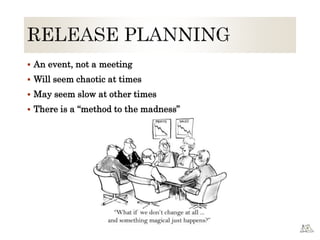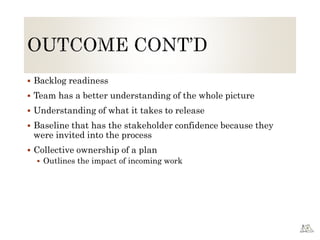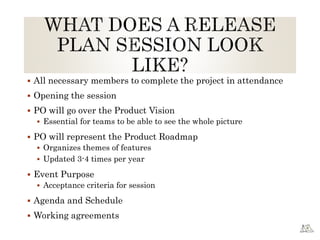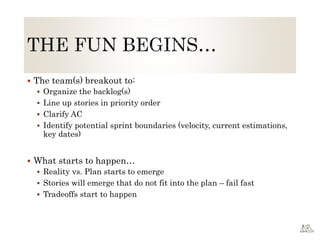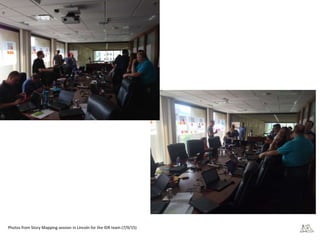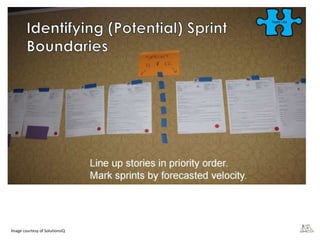Agile camp releaseplanning
- 2. AGENDA Why is this important? When should the team release plan? What does release planning look like? Closing your release plan and what comes next?
- 3. An event, not a meeting Will seem chaotic at times May seem slow at other times There is a “method to the madness”
- 4. Helps the Product Owner and whole team to determine how much MUST be developed, and how long that will take before they have a releasable product. Serves as a guide to which the team can progress Shows how iterations fit into the “whole” Extends visibility past a single sprint to help make informed decisions Gives the scrum team(s) a chance to understand the complete set of functionality in the product
- 5. Create a Release Plan that provides the following: Initial agreement, update current commitments Allows external teams/sources to understand goals and objectives Risks and Dependencies to be identified To allow the organization to make informed decisions and support the plan Where you are Where you want to be Lots and lots of work
- 6. Backlog readiness Team has a better understanding of the whole picture Understanding of what it takes to release Baseline that has the stakeholder confidence because they were invited into the process Collective ownership of a plan Outlines the impact of incoming work
- 7. Whenever you need greater than 1 sprint’s worth of visibility into the plan Multiple teams are potentially involved After you have established the team(s) velocity
- 8. Will take 1-2 days of planning and at least a few weeks of preperation Story mapping can happen before or during, but it will stretch the planning session if done together 3-4 times a year based on average PO, Team, SH(s) Product backlog Prioritized backlog by PO Estimated backlog What is the purpose you hope to accomplish Release theme Current state of team Velocity? DoD Will everyone be in attendance (contingency plans) Key members
- 9. All necessary members to complete the project in attendance Opening the session PO will go over the Product Vision Essential for teams to be able to see the whole picture PO will represent the Product Roadmap Organizes themes of features Updated 3-4 times per year Event Purpose Acceptance criteria for session Agenda and Schedule Working agreements
- 10. The team(s) breakout to: Organize the backlog(s) Line up stories in priority order Clarify AC Identify potential sprint boundaries (velocity, current estimations, key dates) What starts to happen… Reality vs. Plan starts to emerge Stories will emerge that do not fit into the plan – fail fast Tradeoffs start to happen
- 11. Photos from Story Mapping session in Lincoln for the IDR team (7/9/15)
- 12. Image courtesy of SolutionsIQ
- 13. After the team(s) breakout a “Walk the Walls” activity happens An opportunity for the teams to walk the room and talk to other teams. Identifies potential dependencies Identifies duplicated efforts Helps to align work between teams After a “Walk the Walls” happens or if only 1 team, now it is an opportunity for the PO to “Walk the Wall” with the SH(s). Once complete, feedback and information comes back to the teams for another breakout session to work on changes and/or “solidify” current plan
- 14. Team(s) come back together to share plans Go over any decisions made Go over any action items and set boundaries around them Team Commitment Step through session criteria to verify all AC’s have been met Quick closing retro Thank everyone for the participation Head into Sprint Planning which should be much easier “Plans are worthless but planning is everything.” Dwight D. Eisenhower
- 15. Image courtesy of SolutionsIQ
Editor's Notes
- Add personal notes


